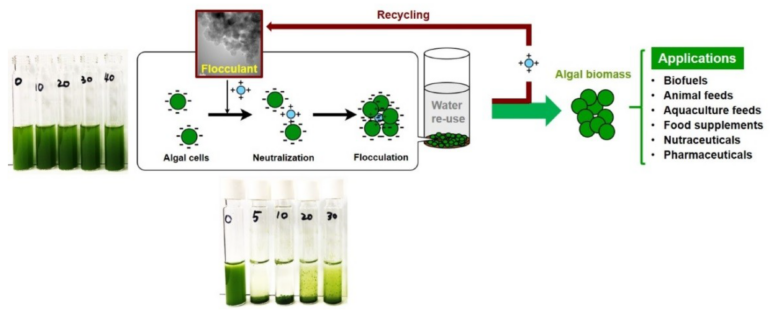From the air you breathe to the seafood you eat, marine algae have some involvement—they consume carbon dioxide and produce oxygen through photosynthesis and feed fish and shellfish. One day, marine algae could also be used to make widely available eco-friendly plastics or fuel.
But growing algae for commercial purposes—called aquaculture—often requires a lot of carbon dioxide to speed up growth. That carbon dioxide is usually sourced from natural gas refineries, where it is compressed into tanks and transported for injection into ponds used to grow algae. Processing and transporting that carbon dioxide creates enough emissions to cancel out any benefit of carbon dioxide removal from algae cultivation.
So how to make aquaculture more carbon neutral? Researchers from the Department of Energy’s (DOE’s) Pacific Northwest National Laboratory (PNNL) may have an answer: couple algae cultivation with marine carbon dioxide removal (mCDR).
Researchers from PNNL’s Sequim laboratory showed that the acid byproduct of an electrochemical process used to increase ocean alkalinity can be used to grow more algae, faster.
Not only are these results a possible boon to the aquaculture industry, but they could also address the need for a sustainable way to use the acid byproduct—a main barrier today to scaling-up some electrochemical mCDR techniques.
“By joining the technological and nature-based methods of carbon dioxide removal, we can create a more sustainable process. The algae neutralize the acid, making the stream suitable for return to the ocean, and the combined process increases the overall carbon dioxide removed from the atmosphere,” said Chinmayee Subban, a chemist at PNNL and co-author on the research published in Environmental Science & Technology Letters.
Removing acid, producing base
Ocean acidification is one of the most pervasive effects of climate change. Ocean water is naturally slightly alkaline, but as it absorbs excess carbon dioxide from the atmosphere, its pH drops, leading to ocean acidification. The acidic seawater degrades the material that sea creatures like snails, clams, and mussels use to build their shells, as well as the branching and bulbous structures of corals.
To remove acidity from seawater, scientists have developed an electrochemical technology called bipolar membrane electrodialysis, which uses electricity to split seawater.
The process is related to technologies widely used to purify drinking water or to concentrate fruit juices. The system uses a combination of electricity and membranes to turn seawater into an acidic stream, a basic stream, and a deionized stream. In theory, the basic and deionized streams could be returned to the ocean to increase its alkalinity—this process is known as ocean alkalinity enhancement.
Adding more alkalinity to the ocean could neutralize the increased acidity of the ocean. In turn, the more alkaline seawater could absorb additional carbon dioxide from the atmosphere without exacerbating acidification. It’s like taking an antacid tablet for heartburn: the basic molecules in the antacid react with and neutralize stomach acid.
But one big challenge remains: What to do with the large volumes of acid stream generated by the process?
That’s where algae come in.
The carbon-eating power of algae
The ocean’s algae are photosynthetic powerhouses, gobbling up carbon dioxide and producing massive amounts of oxygen. In fact, 50–60% of the oxygen in the air you’re breathing right now was likely produced by marine algae, said Scott Edmundson, a biologist at PNNL-Sequim and co-author on the new paper.
Because of its ability to vacuum up carbon dioxide and grow quickly, researchers have in recent years started to explore algae cultivation as a natural way to remove excess carbon dioxide from the atmosphere.
“We can get very complicated in all of our technological solutions for capturing gigatons of carbon dioxide from the atmosphere, but algae and plants can use it in photosynthesis, which is this beautiful natural process that already provides the basis for most of our human needs,” Edmundson said.
In the lab, the researchers first ran seawater through a bench-scale electrochemical device to produce the acidic stream. They then added the stream to flasks growing Picochlorum celeri, a fast-growing species of microalgae.
The acid reacted with seawater to make carbon dioxide more available, which the algae then used for faster photosynthesis. Ultimately, the researchers found that the algae fed the acidic liquid grew about three times faster than the algae without.
“We knew the algae needs the carbon dioxide. We knew that it is known to increase growth rates if you pump that carbon dioxide from a tank into an algae growth pond. But the ocean already holds a lot of carbon dioxide,” Subban said.
“The acid is just that catalyst that’s releasing it, and in this particular case, we showed that you can use this waste acid stream to grow more algae,” Subban said.
Edmundson and Subban imagine a future where electrochemical marine carbon dioxide removal could be linked to the aquaculture industry to grow algae. The algae could then be used for products like biofuels or for feeding mussels and clams for the shellfish industry.
Staving off climate change won’t take just a single technology, or even two or three, Edmundson said. “We need to think about it as an ecosystem instead of separate technologies.”
More information:
Charles F. Hibbeln et al, Maximizing Marine Carbon Removal by Coupling Electrochemical and Biological Methods, Environmental Science & Technology Letters (2024). DOI: 10.1021/acs.estlett.4c00107
Provided by
Pacific Northwest National Laboratory
Citation:
Researchers harvest acid from seawater to feed beneficial algae (2024, June 14)



